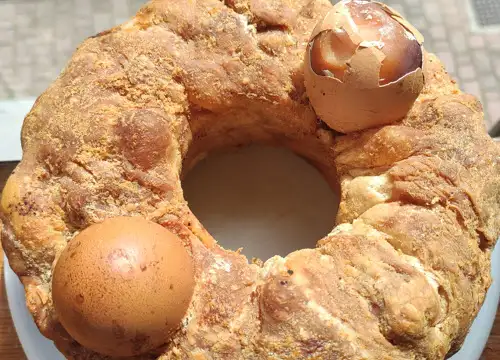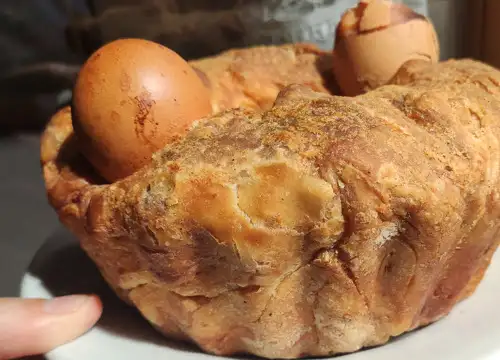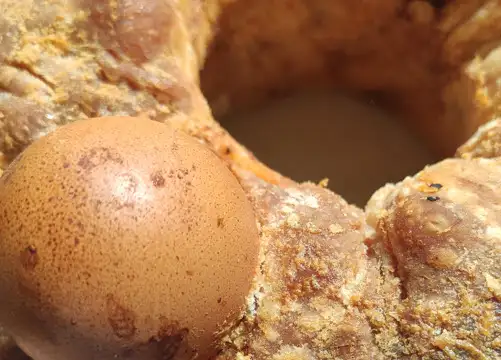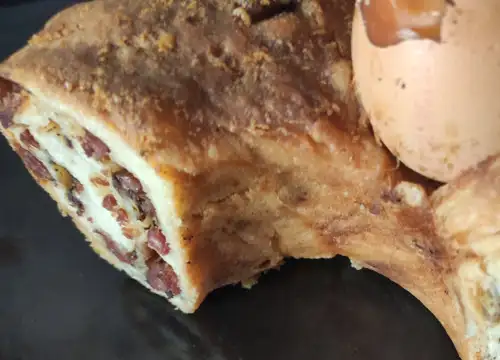Published:
Author: Antonio Maria Guerra
Neapolitan Casatiello
THE COMPLETE GUIDE TO THE EASTER SAVORY BREAD

Neapolitan casatiello is one of those savory specialties that cannot be missed on the tables of the ‘City of the Sun’ during the Easter holidays: a centuries-old tradition that is renewed year after year. In this guide we will discover the reasons for its great fame, starting with a brief look at the recipe and then exploring the variations, pairings, nutritional values, and much more. We will also try to understand how it differs from its close relative, the ‘tortano’. Enjoy reading!

What is Casatiello?
Casatiello is the most classic of the savoury cakes belonging to the Neapolitan culinary tradition and is typically served during the gargantuan libations of the Easter holidays.
Made with dough very similar to bread dough, enriched with lard, and filled with a mixture of cheeses and cured meats, it’s characterized by its typical doughnut shape and the whole eggs embedded in the surface. Its taste is both simple and addictive.
In Naples, this specialty, rich in religious references, is also a symbol of family tradition and conviviality.
Naples, the ‘cradle’ of casatiello.
Casatiello is closely linked to Naples, which can be considered its ‘cradle’. This suggestive crown of bread, topped with whole eggs and garnished with cured meats and cheeses, is the fruit of centuries of evolution: a tradition that probably began when the city was called Neapolis and was one of the most active commercial centers of Magna Graecia. The current version of the specialty dates back to the 17th century, when housewives began to prepare it in the kitchens of their ground floor flats (‘bassi’) to celebrate Easter. Still today, at the right time of year, walking through the ‘vicoli’, the typical narrow alleys of the ‘City of the Sun’, the scent of casatiello mixes with that of incense from the churches, creating a unique ‘sensory landscape’.

Casatiello recipe. (hints)
Neapolitan casatiello is nothing more than bread stuffed with a mix of a few ingredients, particularly rich in flavor, whose combination gives to the specialty the taste for which it has become famous. Let’s explain, in brief, the steps to prepare it:
01 – The dough is made by mixing flour, water, lard, brewer’s yeast, salt, and pepper;
02 – This next step is the leavening, during which the dough grows in volume;
03 – Prepare the filling by mixing ‘Napoli’ type salami, provolone cheese (both diced), and pecorino cheese (grated);
04 – Once the leavening is complete, the filling is placed inside the dough and this is rolled onto itself;
05 – This roll is then placed in a round, donut-shaped, baking dish;
06 – Raw eggs are arranged on the surface of the dough, spacing them apart from each other;
07 – A couple of strips, made from the dough, is fixed on top of each egg;
08 – The procedure ends with the baking in an oven at a temperature of about 180°/200°;
For more detailed information on this procedure, please visit one of the many sites dedicated to recipe illustration.
The preparation on video.
In this video the preparation of the original Neapolitan casatiello is explained. Thanks to Chef Franco, the YouTube channel author and owner of the film.

The right wine for the specialty.
What wine to choose to accompany a tasty slice of casatiello?
Read more
If you want one from the same area of the specialty, the choice could fall on Aglianico: this red wine, thanks to its acidity and sapidity, is just perfect to balance the strong fattiness of the savory cake.

Casatiello vs. tortano: the differences.
Casatiello and ‘Tortano’ are two Neapolitan specialties very similar to each other: so, beyond the name, it’s quite easy to confuse them. It’s therefore appropriate to explain exactly in what they differ:
- Appearance: the classic casatiello has a few eggs neatly arranged on its circular surface. Tortano has none at all;
Filling: the filling of Tortano is almost the same as that of casatiello, except for the addition of hard-boiled eggs (which are inside the cake instead of on top of it);
Period of availability: while casatiello is an Easter specialty, Tortano is prepared also outside this holiday period.
Symbology: casatiello is rich in symbolic references to Easter, most of them part of its appearance (such as the eggs on the top). Tortano, on the other hand, is completely devoid of them.


The origin of the name ‘tortano’.
As is easy to guess (if you know the Italian language), the name ‘tortano’ derives from the word ‘torta’ (‘cake’). Less obvious is the meaning of the desinence ‘-no’, which could refer to the size of the specialty or to the fact that it’s sweet rather than savory.

The variants of Neapolitan casatiello.
As a ‘container of taste’, Casatiello is particularly suited to express itself in a large number of variants. These include the exquisite Casatiello con Salsiccia e Friarielli (Casatiello with Sausage and turnip greens) and the very traditional Casatiello Caso e Pepe, enriched with cheese and pepper. There is even a sweet version, in which the lard in the dough is replaced with butter.

The Casatiello ‘stracciato’.
Considering Casatiello ‘stracciato’ (‘torn’) a variant of the classic one is only partially true.
That’s because teir recipes are basically the same: what changes is that, in the ‘stracciato’ the ingredients of the filling, instead of being placed inside the dough, thus staying ‘grouped’, are mixed with it when it’s made: this leads to their even distribution.

Where to buy the original casatiello?
Here follows a short list of the most traditional Neapolitan rotisseries where to buy Casatiello:
- Panificio Rescigno
Addr.: Via Domenico Cirillo, 74 Naples (Italy)
Tel.: +39 081/3723449 - Panificio Coppola
Addr.: Via Pignasecca, 35 Naples (Italy)
Tel.: +39 081 5520299
Read more
Bar Augustus
Addr.: Via Toledo, 147 Naples (Italy)
Tel.: +39 081 5513540Antico Panificio Ciro Pace
Addr.: Via Nazionale, 84 Naples (Italy)
Tel.: +39 081 268547Pasticceria Ranaldi
Addr.: Vico Lungo Gelso, 97 Naples (Italy)
Tel.: +39 081 400773

Sweet casatiello.
Among the many types of Casatiello, the sweet one is certainly one of the most original and tasty. Its variants are many since every family in Campania has its own interpretation of this specialty. Among them, however, there is one that is more ‘official’ than the others: the Casatiello Dolce di Monte di Procida (a De.Co. product), made with flour, eggs, suet, sugar, liqueur, orange juice, and ‘criscito’, the dialect name for mother yeast. After baking, the casatiello is decorated with a glaze made of egg whites and powdered sugar, to be finally sprinkled with colored confetti, also known as ‘diavulilli’.
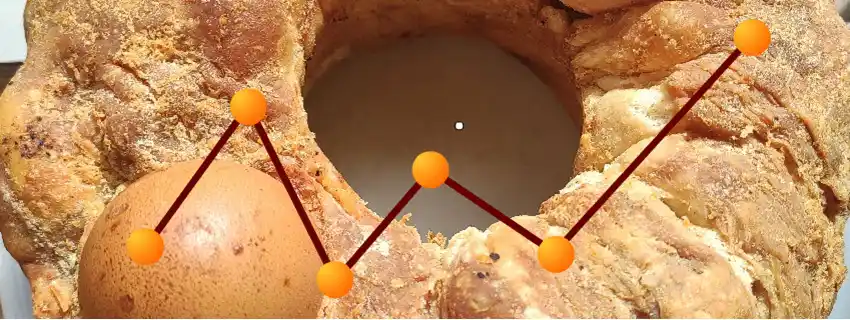
Casatiello: calories and nutritional values.
Casatiello is a very undietary specialty: below are the calories and nutritional values per 100gr of a delicacy that, nevertheless, is absolutely essential:
- Calories: 50/400kcal (ca.);
- Carbohydrates: 40/44 gr (ca.);
- Fats: 15/18gr (ca.);
- Proteins: 14/16gr (ca.);
Abundant amounts of B vitamins (B1, B2, B6, B12) are present. Small concentrations of vitamins A, D and E are not lacking.
Let’s find out the history of Neapolitan casatiello and many interesting facts in the article we dedicated to the delicious Easter specialty.
Copyright information.
The images displayed in this page belong to WebFoodCulture.

